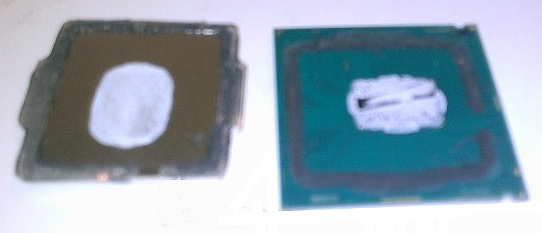Although Intel Corp.’s upcoming Core i7-6700K “Skylake-S” chip will likely become overclockers’ new darling, it looks like it will have the same drawback as currently available mainstream microprocessors with unlocked multiplier: inefficient internal thermal interface.
As reported, Intel Corp. started to ship production ready full-speed engineering samples of its next-generation desktop microprocessors code-named “Skylake-S” to its partners in early June. Thanks to the fact that the new chips are now available relatively widely (but not commercially), more information about them is getting revealed these days. According to a recent discovery by a Coolaler forum member, the new Intel Core i7-6700K processors will allegedly continue to use thermal paste as their internal thermal interface between die and heat-spreader (if the blurry photo below is to be believed), a bad news for overclockers.
In the last 15+ years virtually all desktop microprocessors from Intel featured metallic heat-spreaders (which many call lids) on their dies to protect the latter from damages and enable more efficient heat dissipation. For many years, Intel soldered dies to heat-spreaders using an exceptional Indium-based alloy, which enabled very efficient transfer of heat from silicon to metal. However, starting from the code-named “Ivy Bridge” central processing units Intel replaced the solder with a layer of thermal paste, which is considerably less efficient than the previously used alloy. For high-end desktop (HEDT) microprocessors, such as Intel Core i7 Extreme “Haswell-E”, the world’s largest chipmaker continues to use solder, thus providing exceptional thermal conductivity.
Many overclockers complained that in order to unlock maximum overclocking potential of the Core i7-3770K and the Core i7-4770K microprocessors they had to remove the heat-spreaders (de-lid the chips) and change thermal interface. To improve overclocking potential of its Core i7-4790K and Core i5-4690K “Devil’s Canyon” processors last year, Intel started to use its next-generation polymer thermal interface material, which is not bad, but is not as efficient as commercially available high-end thermal compounds.
As it appears from the blurry photo published at Coolaler forums, Intel will not solder heat-spreaders to its mainstream processors for enthusiasts, even if such chips are aimed at overclockers and are designed to run at high clock-rates. Apparently, if one wants to overclock Intel’s new chips to the max, he or she will need to switch Intel’s NGPTIM thermal interface first.
The blurry photo also reveals that the die size of Intel’s “Skylake-S” microprocessor is not large at all, which is means that it will be easy to overclock it; but its thermal density will be high, which means that it will not be easy to cool it down.
Intel Core i7-6700K central processing unit integrates four cores with Hyper-Threading and features 4.0GHz frequency, 4.20GHz maximum Turbo Boost clock-rate, 8MB last-level cache, a dual-channel DDR3L/DDR4 memory controller with 1600MHz or 2133MHz support, 95W TDP, Intel HD Graphics 6000-series integrated graphics core as well as LGA1151 packaging. The chip is expected to hit the market in August.
Intel did not comment on the news-story.
Discuss on our Facebook page, HERE.
KitGuru Says: As it appears, Intel simply does not want to enable maximum overclocking potential for its mainstream microprocessors. Enthusiasts can now only hope that Intel will use some kind of second-generation NGPTIM to maximize overclocking potential. Unfortunately, large corporations are usually pretty conservative with their choice of materials…
 KitGuru KitGuru.net – Tech News | Hardware News | Hardware Reviews | IOS | Mobile | Gaming | Graphics Cards
KitGuru KitGuru.net – Tech News | Hardware News | Hardware Reviews | IOS | Mobile | Gaming | Graphics Cards



